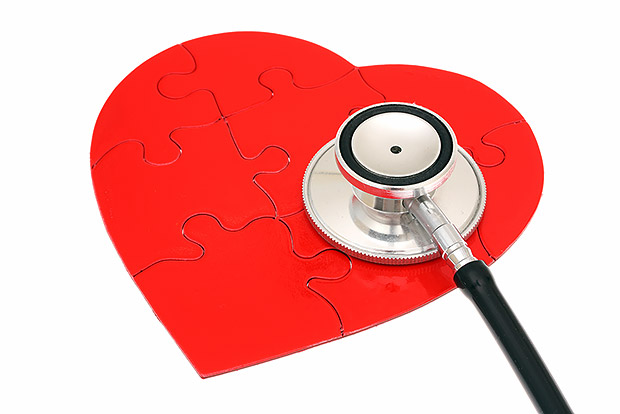
A heart attack occurs when the blood flow bringing oxygen to the heart is cut off. Factors such as lifestyle, family history, and age contribute to this narrowing and blockage of the arteries. Knowing your health status and where you stand with these factors will help you predict your risk.
Waist-to-Hip Ratio
Many researchers now believe that waist measurements are better predictors of heart attack risk than BMI. A waist-to-hip ratio measurement estimates your body fat pattern. People who have an apple shape carry more weight around the middle. Apples are considered at greater risk because of visceral fat (the dangerous fat stored around the organs linked to disease). Pear-shaped individuals carry less weight around the middle and more weight around the hips and thighs which is not considered as dangerous as belly fat. The waist-to-hip ratio is determined by dividing the circumference of your waist by the circumference of your hips. Men should aim for a value of less than 1.0, and women should aim for less than 0.8. (Calculate your waist-to-hip ratio.)
Waist Circumference
Another measurement used to estimate visceral fat is waist circumference. There is some debate as to whether the waist-to-hip ratio or the waist circumference measurement is a better predictor of a heart attack. Some studies state waist circumference as the preferred method. Others indicate that when only a waist measurement is used, the risk is underestimated. Consider using both methods to better determine your risk. Men should aim for a waist circumference of fewer than 40 inches (102 centimeters), and women less than 35 inches (88 centimeters).
Blood Cholesterol
Elevated blood cholesterol increases your risk for cardiovascular disease. The American Heart Association recommends that adults have their cholesterol tested every 4-6 years. If your total cholesterol is 200-239 mg/dL, it is considered borderline high, putting you at greater risk for heart disease. Total cholesterol at 240 mg/dL or higher is considered high risk. The following activities can help lower your cholesterol:
- Lose weight
- Increase aerobic exercise
- Stop smoking
- Reduce saturated fat and dietary cholesterol intake
- Increase soluble fiber intake
- Medication
Blood Pressure
High blood pressure (hypertension) puts stress on the blood vessels causing damage that leads to an increased risk of heart attack and stroke.
| Systolic mmHg |
Diastolic mmHg |
|
| Hypotension | < 90 |
< 60 |
| Normal | 90-120 |
60-80 |
| Prehypertension | 120-139 |
80-89 |
| High Blood Pressure Stage 1 Hypertension |
140-159 | 90-99 |
| High Blood Pressure Stage 2 Hypertension |
160+ | 100+ |
| Hypertensive Crisis Emergency Care Needed |
180+ | 110+ |
The following activities can help lower your blood pressure:
- Lose weight
- Increase aerobic exercise
- Stop smoking
- Reduce sodium and alcohol intake
- Increase potassium and vitamin D intake
- Medication
Blood Sugar
A fasting blood glucose of 100 mg/dL or above is an indicator of insulin resistance. When insulin is not working effectively to help cells absorb blood glucose, this puts you at risk for elevated blood sugar, which leads to diabetes. Since high blood sugar damages arteries, diabetes is another risk factor for heart disease.
Body Mass Index
Body Mass Index (BMI) is determined by dividing your weight in kilograms by your height in meters squared. The resulting number is used to categorize your weight status as normal (18.5 to 24.9), overweight (25 to 29.9), and obese (30 and greater). BMI has been used for many years as a tool to predict health risks, but researchers now recognize its limitations. While it is not the best method for predicting heart disease, it remains a simple tool to help you keep your weight in check. Aiming for a healthy weight can help you reduce the health risks that come with being overweight, including heart disease and heart attack. (Calculate your BMI.)
Smoking and Secondhand Smoke
Smoking and inhaling secondhand smoke damages the arteries and causes deposits of cholesterol to collect on arterial walls. Over time this decreases blood flow, increasing the risk of a heart attack. Limit your exposure to secondhand smoke, and if you smoke, stop. Talk to your doctor about the many successful programs that can help you stop smoking and improve your health.
Sources



 4 Tips for Healthy Office Meetings
4 Tips for Healthy Office Meetings
 11 Healthy Distractions to Help You Stop Snacking
11 Healthy Distractions to Help You Stop Snacking
 6 Tips for Hosting a Healthy Party
6 Tips for Hosting a Healthy Party
 10 Ways to Cut 100 Calories (or more!)
10 Ways to Cut 100 Calories (or more!)
 8 Ways to Celebrate Your Weight Loss
8 Ways to Celebrate Your Weight Loss
 Healthy Changes You Can Make in Minutes
Healthy Changes You Can Make in Minutes
 6 Grocery Shopping Mistakes
6 Grocery Shopping Mistakes
 Tips to Prevent High Blood Pressure
Tips to Prevent High Blood Pressure

 Pinterest
Pinterest RSS Feed
RSS Feed